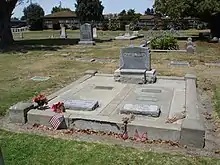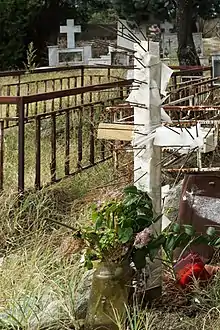


A grave is a location where a dead body (typically that of a human, although sometimes that of an animal) is buried or interred after a funeral. Graves are usually located in special areas set aside for the purpose of burial, such as graveyards or cemeteries.[1]
Certain details of a grave, such as the state of the body found within it and any objects found with the body, may provide information for archaeologists about how the body may have lived before its death, including the time period in which it lived and the culture that it had been a part of.
In some religions, it is believed that the body must be burned or cremated for the soul to survive; in others, the complete decomposition of the body is considered to be important for the rest of the soul (see bereavement).
Description

The formal use of a grave involves several steps with associated terminology.
- Grave cut
The excavation that forms the grave.[2] Excavations vary from a shallow scraping to removal of topsoil to a depth of 6 feet (1.8 m) or more where a vault or burial chamber is to be constructed. However, most modern graves in the United States are only 4 feet (1.2 m) deep as the casket is placed into a concrete box (see burial vault) to prevent a sinkhole, to ensure the grave is strong enough to be driven over, and to prevent floating in the instance of a flood.
- Excavated soil
The material dug up when the grave is excavated. It is often piled up close to the grave for backfilling and then returned to the grave to cover it. As soil decompresses when excavated and space is occupied by the burial not all the volume of soil fits back in the hole, so often evidence is found of remaining soil. In cemeteries, this may end up as a thick layer of soil overlying the original ground surface.
- Burial or interment
The body may be placed in a coffin or other container, in a wide range of positions, by itself or in a multiple burial, with or without personal possessions of the deceased.
A vault is a structure built within the grave to receive the body. It may be used to prevent crushing of the remains, allow for multiple burials such as a family vault, retrieval of remains for transfer to an ossuary, or because it forms a monument.
- Grave backfill
The soil returned to the grave cut following burial. This material may contain artifacts derived from the original excavation and prior site use, deliberately placed goods or artifacts, or later material. The fill may be left level with the ground or mounded.
- Monument or marker
Headstones are best known, but they can be supplemented by decorative edging, footstones, posts to support items, a solid covering or other options.
Graveyards and cemeteries
.JPG.webp)


Graveyards were usually established at the same time as the building of the relevant place of worship (which can date back to the 8th to 14th centuries) and were often used by those families who could not afford to be buried inside or beneath the place of worship itself. In most cultures those who were vastly rich, had important professions, were part of the nobility or were of any other high social status were usually buried in individual crypts inside or beneath the relevant place of worship with an indication of the name of the deceased, date of death and other biographical data. In Europe, this was often accompanied by a depiction of their family coat of arms.
Later, graveyards have been replaced by cemeteries.
In language
- Turn in one's grave is an idiom to describe an extreme level of shock or an intense level of surprise and is expressed as the vicarious sentiment of a deceased person.
See also
- Stećak
- Bereavement in Judaism
- Burial at sea
- Cenotaph
- Christian burial
- Cremation
- Crypt
- Dolmen
- Funeral pyre
- Funerary art
- God's Acre
- Gravedigger
- Islamic funeral
- Mass grave
- Maqbara
- Mausoleum
- Monumental inscription
- Natural burial
- Necropolis
- Premature burial
- Pyramid
- Tomb
- Tophet
- Tumulus
- Turn in one's grave
- War grave
References
- ↑ Tütüncü, Mehmet (2015). "The Uppsala Mecca Painting: A New Source for the Cultural Topography and Historiography for Mecca". In Buitelaar, Marjo; Mols, Luitgard (eds.). Hajj: Global Interactions through Pilgrimage. Leiden: Sidestone Press. pp. 137–163. ISBN 978-90-8890-285-7.
- ↑ Ghamidi (2001), Customs and Behavioral Laws Archived 2013-09-23 at the Wayback Machine
External links
 Media related to Graves at Wikimedia Commons
Media related to Graves at Wikimedia Commons Quotations related to Grave (burial) at Wikiquote
Quotations related to Grave (burial) at Wikiquote The dictionary definition of grave at Wiktionary
The dictionary definition of grave at Wiktionary
